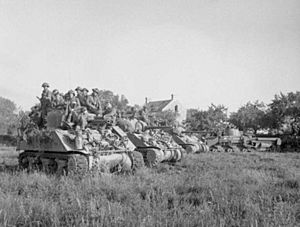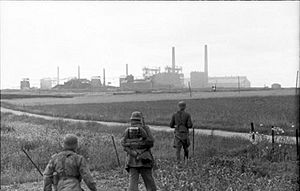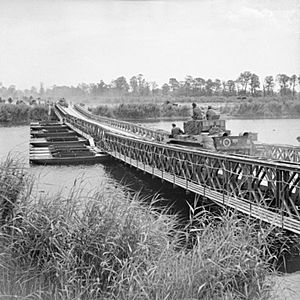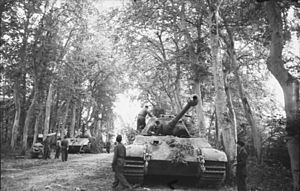Operation Goodwood facts for kids
Quick facts for kids Operation Goodwood |
|||||||
|---|---|---|---|---|---|---|---|
| Part of the Battle for Caen | |||||||
 Two M4 Sherman tanks, a Sherman Firefly carrying infantry and a Sherman Crab wait for the order to advance at the start of Operation Goodwood, 18 July |
|||||||
|
|||||||
| Belligerents | |||||||
| Commanders and leaders | |||||||
| Bernard Montgomery Miles Dempsey John Crocker Richard O'Connor |
Günther von Kluge Heinrich Eberbach Sepp Dietrich Hans von Obstfelder |
||||||
| Strength | |||||||
| 3 armoured divisions (c. 1,100 tanks) 2 infantry divisions 1 armoured brigade |
3 armoured divisions 2 heavy tank battalions (377 tanks) 4 infantry divisions |
||||||
| Casualties and losses | |||||||
| 4,000–5,000 217–500 tanks |
2,000 prisoners 75–100 tanks |
||||||
| Operation Goodwood | |
|---|---|
| Operational scope | Operation as part of an offensive strategy |
| Planned by | Second Army |
| Objective | See Aftermath section |
| Executed by | Second Army, VIII Corps and supporting attacks by I Corps |
Operation Goodwood was a major British attack during World War II. It happened in Normandy, France, from July 18 to 20, 1944. This operation was part of the bigger Battle for Caen. The goal was to push south from a bridgehead (a secure area across a river). They wanted to capture the rest of the city of Caen and a nearby high area called the Bourguébus Ridge. Some historians say this was the biggest tank battle the British Army has ever fought.
Before Goodwood, other smaller operations happened to distract the German forces. When Goodwood started, the British VIII Corps attacked with three armoured divisions. They aimed to take the Bourguébus Ridge and cause heavy losses to the Germans. On July 18, the British I Corps also attacked nearby villages. At the same time, Canadian forces launched Operation Atlantic to capture parts of Caen south of the Orne River. By July 20, the British tanks had broken through some German defenses. They advanced about 7 miles (11 km) but were stopped before reaching the main Bourguébus Ridge.
Even though Goodwood didn't fully reach its main goal, it was important. It forced Germany to keep many strong tank units fighting the British and Canadians. This made it easier for the American forces. Their attack, Operation Cobra, started on July 25. The weaker German defenses facing the Americans then collapsed.
Why Operation Goodwood Happened
The Battle for Caen
The city of Caen was a key target for the British on D-Day, June 6, 1944. Capturing Caen was very important for the Allied forces. It would give them space for airfields and protect the side of the American army. The land around Caen was open and good for fast-moving tank battles. The Allies had many more tanks than the Germans, so this type of battle was an advantage for them.
However, the British 3rd Infantry Division could not capture Caen on D-Day. German resistance was strong. Later attempts, like Operation Perch, also failed. A big storm in the English Channel in mid-June further delayed Allied plans. This storm lasted three days and made it hard to bring more troops and supplies to Normandy.
Earlier British Attacks
After the storm, the British tried again to capture Caen. Operation Epsom started on June 26. New British troops attacked west of Caen, trying to surround the city. But the Germans fought hard and stopped this attack. Then, the British launched Operation Charnwood, a direct attack on Caen. By July 9, the northern part of Caen was captured. However, the Germans still held the southern bank of the Orne River. They also held important places like the Colombelles steel works. The tall chimneys of the steel works were perfect lookout points for German observers.

After capturing northern Caen, the British tried to take the Colombelles steel works. But this attack failed. The factory area stayed in German hands. Its tall chimneys still gave the Germans a great view of the area.
General Montgomery's Plan
On July 10, General Bernard Montgomery, who led all Allied ground forces in Normandy, met with his commanders. They talked about future attacks. Montgomery approved Operation Cobra, an American attack set for July 18. He told the British commander, General Dempsey, to keep attacking the Germans. The goal was to "wear down" German forces, especially their tanks. This would make it easier for the American attack.
The British were running low on infantry (foot soldiers). So, General Dempsey suggested an attack using mostly tanks. By mid-July, the British had many tanks in Normandy. They had three armoured divisions ready for battle.
On July 13, the plan for Operation Goodwood was made. It was named after a famous horse race. The first orders were general, but they helped everyone start planning.
Planning the Attack
The Goodwood Plan Details
The plan for Goodwood was for the British VIII Corps to attack south. They would start from the Orne bridgehead, an area the Allies had captured on D-Day. The 11th Armoured Division would lead the attack. Their goal was to reach the Bourguébus Ridge and the Caen–Falaise road. The Guards Armoured Division would follow, aiming for other towns. The 7th Armoured Division would move south towards Falaise.
At the same time, the British 3rd Infantry Division would secure the eastern side of the attack. The Canadian forces would launch Operation Atlantic. This would be a supporting attack on the western side of the British forces. Their goal was to capture the rest of Caen south of the Orne River. Both British and Canadian operations were planned for July 18.
Montgomery later changed the plan from a "deep breakthrough" to a "limited attack." The main goal was to fight the German tanks and weaken them. This would help the American attack. The armoured divisions were told to "dominate the area Bourguébus–Vimont–Bretteville." But they could send armoured cars further south to cause confusion.
The British army knew a lot about the German forces they would face. They expected strong German defenses. They knew the Germans were waiting for a big attack from the Orne bridgehead. They also knew about several German tank divisions and heavy tank battalions.
To hide their true plans, the British used a deception plan. This included fake attacks in other areas. The three armoured divisions moved to their starting positions only at night. They kept radio silence. Artillery fire was used to cover the noise of the tanks. During the day, they carefully camouflaged their new positions.
Goodwood had huge artillery support. Over 760 guns were ready with hundreds of thousands of shells. These guns would fire to suppress German anti-tank and artillery positions. They would also provide a "rolling barrage" (a moving wall of explosions) for the attacking tanks. Three ships from the Royal Navy would also fire on German gun batteries near the coast.

Engineers worked hard to build new roads and strengthen bridges. This allowed the tanks to move quickly to their starting points. They also cleared 19 wide paths through German minefields. This was done during the night before the attack.
Air Support
Before the ground attack, over 2,000 heavy and medium bombers from the British and American air forces would strike. This was the largest air raid to support ground troops in the war so far. The bombing was meant to clear the way for the 11th Armoured Division to quickly reach the Bourguébus Ridge. Fighter-bombers would also provide close air support. They would attack German positions and stop German troop movements.
German Preparations
The Germans saw the Caen area as vital to their position in Normandy. They built a strong defense line. Villages were fortified, and anti-tank guns were placed along the edges. German intelligence knew a British attack from the Orne bridgehead was likely. They thought the British would push south-east towards Paris.
German reconnaissance flights tried to spot British movements. They saw a lot of traffic moving into the British bridgehead. They also found out that a British plane had crashed while photographing their defenses.

The German LXXXVI Corps held the front line with infantry and tank units. They had many artillery pieces and anti-tank guns, including powerful 88 mm guns. Some of these were placed in villages and on the Bourguébus Ridge. On July 17, Field Marshal Erwin Rommel, a top German commander, was seriously wounded when his car was attacked by a British fighter plane. This left his army group temporarily without a leader.
Distraction Attacks
Before Goodwood, the British launched two distraction operations. Operation Greenline and Operation Pomegranate. These attacks were meant to make the Germans think the main British assault would happen west of the Orne River. They also aimed to tie down German tank divisions so they couldn't fight in Goodwood. These operations cost the British about 3,500 casualties. But they were successful in their goal of distracting the Germans. The Germans suffered about 2,000 casualties and kept their tank divisions fighting in other areas.
The Battle Begins
July 18: The Main Attack
Early on July 18, British infantry quietly moved back from the front line. At 5:45 AM, over 1,000 heavy bombers dropped thousands of tons of bombs on German positions. They targeted the steelworks, German tank positions, and the village of Cagny. At 6:40 AM, British artillery opened fire. Twenty minutes later, more bombers arrived. American bombers dropped fragmentation bombs on German infantry. Fighter-bombers attacked German strong points.
During this 45-minute bombardment, British tanks moved towards their starting line. At 7:45 AM, the artillery started a "creeping barrage." This moving wall of explosions went ahead of the 11th Armoured Division. More artillery fired on German targets further south. American heavy bombers also dropped bombs on the main German gun line on the Bourguébus Ridge. Only 25 bombers were lost to German anti-aircraft fire.

The bombing temporarily put some German tank units out of action. Many German front-line positions were destroyed. But dust and smoke made it hard for bombers to hit all targets. Some areas, like Cagny and Émiéville, were heavily bombed. But many defenders survived and were ready to fight. On the Bourguébus Ridge, some guns were destroyed, but most remained.
By 8:05 AM, the lead British tank regiments had crossed the railway line. They moved through minefields. German resistance was still light, and many prisoners were taken. But the tanks struggled to keep up with the artillery barrage. They were moving out of range of their support.

As the tanks advanced past Cagny, they were hit by German anti-tank guns. Many tanks were disabled. The British tanks kept pushing south. They were then hit by the main German gun line on the ridge. What was planned as an attack by three armoured divisions became an unsupported advance by two tank regiments. They were out of sight of each other and faced heavy German fire. By 11:15 AM, the British reached the ridge and some villages. But further advances were met with strong resistance.
General Eberbach ordered a German counter-attack. The 1st SS Panzer Division was to attack across the ridge. The 21st Panzer Division was to take back lost ground in the Cagny area. German tanks arrived around noon. British tank crews reported German tanks and guns everywhere. British fighter-bombers with rockets attacked the ridge all afternoon. This delayed and broke up the German counter-attack. A final attempt to storm the ridge by the British led to the loss of 16 tanks. A small German counter-attack was stopped, with six German tanks destroyed.
Just before 10:00 AM, the Guards Armoured Division caught up. They pushed towards Cagny. By noon, they were fighting hard. A German counter-attack with 19 tanks and heavy Tiger tanks failed. The German tanks came under fire from their own guns. Two Tiger tanks were knocked out. One large King Tiger tank was rammed by a British Sherman tank. Both crews left their vehicles. Most of the German crew were captured. It took the Guards the rest of the day to capture Cagny.
The 7th Armoured Division also joined the battle. They knocked out two German tanks and cleared a village. During the night, German bombers attacked the Orne bridges. One bridge was slightly damaged.
On July 18, the Guards Armoured Division lost 15 tanks destroyed and 45 damaged. The 11th Armoured Division lost 126 tanks, though many could be repaired. The armoured divisions had 521 casualties that day. The 3rd Infantry Division on the eastern side had a successful day, capturing most of its targets.
Operation Atlantic: The Canadian Attack
On the Canadian front, Operation Atlantic began at 8:15 AM. Canadian infantry and tanks advanced. By 10:30 AM, they secured the village of Cuverville. But other objectives were strongly held. The rest of the day saw a slow advance as they cleared many German positions. By nightfall, the infantry dug in.
July 19–20: Continued Fighting
German tanks counter-attacked late on July 18. Fighting continued along the high ground and around Hubert-Folie on July 19 and 20. This brought the British attack to a halt. On July 21, the British started replacing their tanks with infantry to secure the ground they had gained.
What Happened After
Counting the Losses
It's hard to know the exact number of losses for both sides in Operation Goodwood. Early estimates said the British Second Army lost over 4,000 men. Other figures suggest around 1,000 to 3,400 British casualties. Operation Atlantic cost the Canadians between 1,300 and 1,900 casualties.
The British took over 2,000 German prisoners. Around 75 to 100 German tanks were destroyed or damaged.
British tank losses during Goodwood have been widely discussed. Figures range from 218 to 500 tanks. Many of these were damaged and could be repaired, not completely destroyed. One study suggests a maximum of 253 tanks were lost, with most being damaged. Another source states 469 tanks were lost by the armoured divisions, but most could be repaired. After much research, one historian found that VIII Corps lost 314 tanks, with 130 completely destroyed. While many tanks were knocked out, many were recovered and put back into service.




